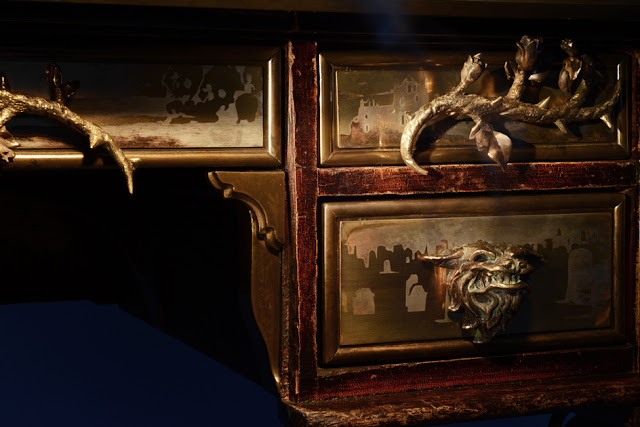| The Dracula Desk |
The
author Bram Stoker (1847-1912) conceived upon this desk the most famous
fictitious literary character on the planet – DRACULA, responsible for
countless film and television productions, the idea of Dracula, ultimate
glam-sex-bloodsucker, is imbedded in world culture. His influences
range from cult status to high street fashion. The vampire fantasy
will never leave our consciousness or is it more accurate to say Dracula’s
legacy is undead?
|
Belgravia
art dealer, Andrew Lamberty acquired the derelict desk whilst appearing on a
TV programme and commented “with no drawers and legs it really could not be
called a desk, let alone an iconic treasure. I knew close friend
Mark Brazier-Jones, celebrated rock and roll master furniture artist, would
be the perfect person to charge with the privilege of its reinvention.”
|
Brazier-Jones
(whose celebrity clients have included Mick Jagger, Sir Elton John, Sir Bob
Geldof, Sylvester Stallone, Janet Jacket and Prince) wanted to keep the desk
complete and intact, to save all its scars and broken varnish, to keep the
history alive within its’ gnarled textures. He has devised an
exoskeleton, encapsulating the original wooden carcass, contrived of
sculptured bronze and burnished steel interwoven with imagery inspired by the
great authors meditations thus restoring functionality and mythology
appropriate to the heritage of this important cultural artefact.
|
Brazier-Jones
explains “ what I have done for the Dracula Desk is similar to what can
historically be found with religious artefacts. For example, a
fragment of a Saints bone or a splinter of wood from the crucifix was kept
within a highly decorated container called a Reliquary. A crusty
old piece of bone on its own might easily be disregarded as
rubbish. It had to be protected by the aura and importance of an
elaborate setting. That setting also had to assist the viewer by
inspiring a sense of awe and reverence conducive to mediation on the historic
significance of the contents. Apparently this desk was once so
disregarded, because of its dilapidated appearance, that it was about to be
used as firewood. From now until the end of history that mistake
cannot happen. The original bit of wood is now protected within a
Reliquary.
|
After
working on the project for what ended up being some four months Brazier-Jones
decided he wished to keep the desk as a personal family
heirloom. Lamberty agreed to a sympathetic buy out and now it
stands proudly in all its brooding splendour at the Brazier-Jones design
studio in Hertfordshire.
|
Provenance
- The Irish born author Bram Stoker (1847-1912) conceived upon this desk the most famous fictitious character on the planet – DRACULA.
- His gothic novel, Dracula, was published in 1897.
- At the beginning of the last Century Stoker gave the desk to his close friend JSR Phillips, editor of the Yorkshire Post from 1903 – 1919, and often stayed with Phillips at his home in ‘Balmoral’, Headingley, Leeds.
- It then passed to his son ER Phillips, chief assistant editor of the Yorkshire Post whose wife disliked the desk and for years it stood outside in their garden at Scotton, near Knaresborough, until with their permission their son, Guy Ragland Phillips, took it to London and repaired it for his own use.
- Ragland Phillips then bought a Victorian property overlooking the sea: 4 Henry Smith’s Terrace, Hartlepool, Cleveland.
- He sold this house to Mrs Gillian Broderick, and left the desk behind.
- The desk is recorded as having part of its legs missing at this time.
- Mrs Broderick, like Ragland Phillips, was a literary type and appreciated the desks history.
- Ragland Phillips confirmed the desks authenticity in a letter to Mrs Broderick dated February 24th 1975, stating that Stoker himself gave the desk to his grandfather with the information that he had written Dracula on it.
- Mrs Broderick kept the letters but did not like the desk so let her son, young master Andrew Broderick, virtually destroy it.
- Andrew Broderick, of Michigan USA stated “it was in my room and the paint on the top of it was from me playing with poster paints on it when I was a little boy. When I was a teenager, I used it as a workbench to build model aircraft and cut the knotch out of the front of it to accommodate a vice. She gave it away to its next owner in 1995 when she moved.”
- Mrs Broderick gave the desk to local author Billy Yull, who lived two doors down and had shown interest in saving the desk for posterity.
- Billy Yull appeared on the popular television art programme ‘Four Rooms’ where Belgravia art dealer Andrew Lamberty purchased the desk, knowing that his friend Mark Brazier-Jones, master furniture artist, would be the perfect person to charge with the honour of reinventing this important cultural artefact.
- The Brazier-Jones studio devised and constructed the bronze and steel fittings and commissioned a leather top from J Saunders of Enfield and upholstery drawer linings from A James of London.
- 19th July 2012 the desk carcass was treated by Thermo Lignum of Grand Union, London, specialists in ecological, museum approved, guaranteed, insect pest eradication with the Thermo Lignum® Warmair process who guarantee it is now free from insect infestation and that this was achieved without the use of chemicals.
www.draculadesk.com
www.brazier-jones.com
To see more of Mark Brazier-Jones work visit: www.brazier-jones.com
www.brazier-jones.com
Princess Chair Marquise Tzar
by Charlotte &
Peter Fiell
Published by: Fiell
Publishing
Hardback: Format:
29.4 x 24.5 cm
176 pages, 200
illustrations
ISBN:
978-1-906863-70-8
To see more of Mark Brazier-Jones work visit: www.brazier-jones.com








